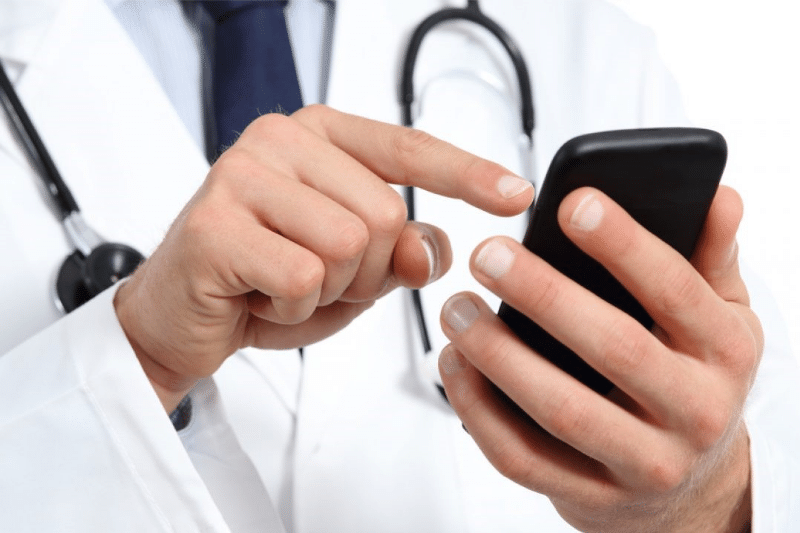Home


Resource Center
The healthcare industry has advanced a great deal in the last decade. From online patient interaction to digital patient files, the explosion of technology is revolutionizing the industry.
With the ubiquity of smartphones and tablets, more people use mobile devices for just about everything, especially their health. Even medical professionals depend on mobile devices for a big part of their practice. Around 62% of physicians report using tablets, for example, and 72% of RNs and other clinical staff use smartphones while caring for patients.
That said, the proliferation of mobile devices has its drawbacks. For starters, the hospital now administration has a lot more to manage. They face the prospects of upgrading old equipment and leveraging new systems to advance patient care. They may need to invest in converting patient files to a digital format and upgrading communication infrastructure to meet the needs of all the new devices. Plus, if you’re going to rely on mobile devices, you have to ensure everyone across your facilities has a reliable signal.
Challenges in Healthcare Technology

It’s no small task to ensure reliable network communication for hundreds or thousands of devices. As the healthcare industry evolves with technology, it’s becoming more and more critical that facilities have secure mobile networks and communication technologies to rely on.
Many of these advances are facilitated through a reliable WiFi connection, but WiFi has its limitations in terms of security. Often, these networks are overwhelmed by patients, staff and visitors all accessing them at once. WiFi networks can also suffer signal interference from building structures and medical equipment. It’s simply not the most reliable solution.
Because of these shifts in patient care, medical professionals are more reliant than ever upon secure mobile networks and data technologies. A reliable cellular signal helps healthcare facilities transition to a digital platform, streamline communications on and off-campus, and maintain a high level of security throughout a facility. It also helps prevent long wait times by speeding up patient check-ins, diagnoses, and test results. But a good cell signal signal can be challenging for some facilities, and this can have very real consequences.
It also helps prevent long wait times by speeding up patient check-ins, diagnoses, and test results. But a good cell signal is challenging for some facilities, with very real consequences.
Consequences of Poor Cellular Signal

Bad cell signals can be isolated or widespread — it all depends on the environment. In the case of CHI St. Luke’s in Lufkin, TX, poor signal was a problem in many parts of the hospital, including the upper patient floors, medical staff meeting room, radiology department, and operating rooms. The lack of service was so poor that it regularly cut off medical staff from their colleagues and patients.
“In the lower parts of the hospital, especially in the first-floor medical staff meeting room, there was no service whatsoever,” said Dr. David Bailey, chief medical officer. “The only way someone could get in touch with you was through paging, and that’s a problem because there’s only one phone in that room.”
Paging was certainly the preferred communication method years ago, but mobile devices have since rendered it obsolete. While the shift has done wonders for communication, it also relies on a strong cell signal. When that signal fails, medical staff is cut off from their colleagues and patients. Even a momentary lapse in communication can lead to long patient waits, poor patient engagement, or inaction in emergency situations.
Fortunately, a passive distributed antenna system (also known as a cell phone signal booster system) can provide a reliable signal so that facilities can stay in consistent contact with patients and colleagues — not to mention streamline processes and enhance patient care.
Overcoming Connectivity Problems

Many hospitals suffering from poor cellular connectivity turn to an active distributed antenna system (DAS) as a solution. There’s no question that active DAS provides a viable connectivity option. These systems use antennas and fiber optic cable to capture a cell signal from a remote source and broadcast it over a wide area, such as a stadium, subway station, or another large area with expansive square footage. Active DAS systems typically create a single-carrier signal — one that boosts signal only for a specific carrier, like Verizon or AT&T.
While active DAS solutions are excellent options for covering vast areas, they are also expensive and take a long time to install. For smaller hospitals and those with limited budgets, a passive DAS solution may be a more viable option.
A passive DAS captures existing cell signals from towers using rooftop antennas. They amplify this weak signal and then rebroadcast it throughout the building. They’re far more affordable than an active DAS and take less time to install. In fact, an entire passive DAS system can be up and running in a matter of weeks and cost much less overall. What’s more, a passive DAS solution is carrier agnostic, meaning it doesn’t matter what carrier the mobile device is using — it just works.
Large medical campuses with passive DAS are typically retrofitted with a number of independent systems. This targeted approach means some buildings are fitted with only a single cellular amplifier, while others, such as a multi-story tower, are fitted with five or more amplifiers. This serves to maximize efficiency and minimize costs.
Improving Connectivity for Devices and People
With a passive DAS system, hospitals eliminate many of the problems associated with bad signal or less-than-reliable Wi-Fi. The administrators at CHI St. Luke’s eventually decided to install one as a solution, and it has improved cell signal throughout their entire campus, eliminating many of the frustrations that hindered quality care.
“Our physicians are happier and our staff’s happier. We’re better connected and quite honestly, I believe it will lead to better care in our hospital,” said Dr. David Glenn, President and Chief Medical Officer for Memorial Clinics.
Upgrading your hospital’s connectivity helps you meet the advanced technological and care demands of modern medicine. With budgets under pressure across the industry, a cost-effective option like passive DAS can help administrators and facility managers eliminate the cellular and network problems that are the norm for many hospitals.
Find out more about how to buy solutions from WilsonPro.

